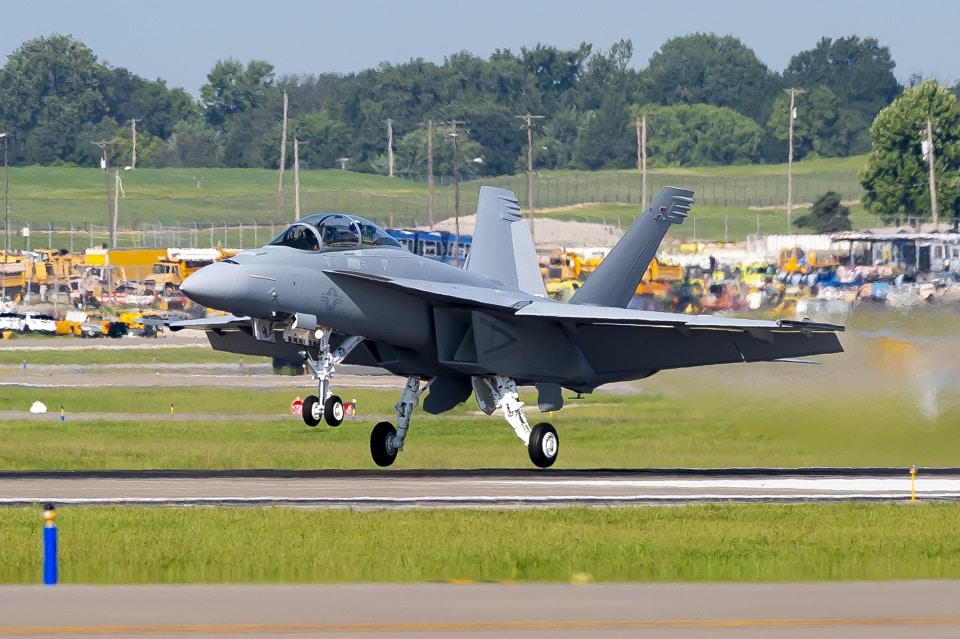Aerospace
Boeing to stop production of F/A-18 Super Hornet jets in 2025.

Boeing may close the F/A 18 production unit by 2025. The Super Hornet fighter aircraft is one of the most successful fighters in US history, having served in the military for over four decades plus. It intends to end manufacturing of the F/A-18 Super Hornet in late 2025, when the last of the fighter jets have been delivered, as the aerospace giant changes its focus to winning the race for sixth-generation combat aircraft.
If India places an order for the F/A 18 fighter jet, the production schedule will be extended until 2027. After the F/A 18 production is completed, the manufacturing facility will be used for other Boeing products such as the T-7A Red Hawk, MQ 25 and F15, and 777x wing components.
Boeing is reallocating resources to future military aircraft projects: Boeing intends to construct three new state-of-the-art facilities in St. Louis to support work on the next generation of advanced crewed and uncrewed aircraft.
Modernization and upgrade initiatives will be prioritized: Boeing will continue to develop enhanced capabilities and improvements for the global F/A-18 Super Hornet and EA-18G Growler fleets. All Block II Super Hornets in Service Life Modification will get the Block III capability suite during the following decade. As part of the ongoing Growler improvements, Boeing will continue to incorporate sophisticated electronic attack capability.
The facility will be used to ramp up production of critical new defense programs, including the T-7A Red Hawk, the world’s first all-digital training system, and the MQ-25 Stingray, the world’s first carrier-deployed autonomous refueling aircraft, in addition to the ongoing production of new F-15EX Eagle IIs and 777X wing components.
Boeing has delivered almost 2,000 Hornets, Super Hornets, and EA-18G Growlers to clients throughout the world, including the United States Navy, Australia, Canada, Finland, Kuwait, Malaysia, Spain, and Switzerland since the F/A-18 debuted in 1983.
Presently, Boeing has offered India the Navy version fighter jet. It also demonstrated the best capabilities of the Indian aircraft carrier INS Vikrant and was displayed at Aero India 2023.
The aircraft played an important role in US defense, and it was upgraded with the most advanced avionics and armament systems.

Aerospace
Boeing Transfers Rocket Stage to NASA, Paving Way for Human Moon Mission

Boeing has achieved a significant milestone by providing NASA with the second core stage of the Space Launch System (SLS) rocket.
This crucial component, crafted at NASA’s Michoud Assembly Facility (MAF), is set to propel the Artemis II crew into lunar orbit, marking humanity’s return to deep space after a 50-year hiatus.
The monumental Boeing-built rocket stage, the largest element of the Artemis II mission, will embark on a journey aboard the Pegasus barge, traveling 900 miles to NASA’s Kennedy Space Center.
Comparison of two legendary aircraft B777x vs B747 aircraft:Click here
Upon arrival, it will be meticulously integrated with other essential Artemis II components, including the upper stage, solid rocket boosters, and NASA’s Orion spacecraft within the iconic Vehicle Assembly Building. This intricate integration process is a vital step toward the eagerly anticipated Artemis II launch, slated for 2025.
“Boeing-built products helped land humankind on the moon in 1969, and we’re proud to continue that legacy through the Artemis generation,” remarked Dave Dutcher, vice president and program manager for Boeing’s SLS program. “Together, with NASA and our industry partners and suppliers, we are building the world’s most capable rocket and paving the way to deep space through America’s rocket factory in New Orleans.”
NASA, Lockheed Martin Reveal X-59 Quiet Supersonic Aircraft:Click here
The delivery of Core Stage 2 marks a significant achievement in the evolution of the SLS rocket. Towering over 200 feet and powered by four RS-25 engines, this core stage, coupled with two solid-fueled booster rockets, will generate a staggering 8.8 million pounds of thrust. This immense power is crucial to launching Artemis II and future missions into the vast expanse of space.
The SLS rocket stands unparalleled in its capability to transport both crew and substantial cargo to the moon and beyond in a single launch. Its extraordinary capacity will facilitate the delivery of human-rated spacecraft, habitats, and scientific missions to destinations including the moon and Mars, ushering in a new era of space exploration.
-

 Travel1 week ago
Travel1 week agoAir India to Expand US Operations with Three New Routes After a Decade
-

 Travel2 weeks ago
Travel2 weeks agoWhy We Should Avoid These Stamps in a Passport
-

 Airlines1 month ago
Airlines1 month agoInvestigations Reveal Fake Chinese Titanium in Boeing and Airbus Jets
-

 Tech4 weeks ago
Tech4 weeks agoChina’s CATL Plans 1,800-Mile Electric Plane Launch by 2027
-

 Airport3 days ago
Airport3 days agoTop 10 Largest Airports in the World by Size
-

 Aerospace4 weeks ago
Aerospace4 weeks agoChina’s Fighter Jets Turn Wings into Autonomous Drones
-

 Airlines4 days ago
Airlines4 days agoAir India Rolls Out A350s for Delhi-New York JFK and Newark Routes
-

 Defence3 weeks ago
Defence3 weeks agoBoeing Enhances Chinook with New Engines and Block II Upgrades at $96 Million







